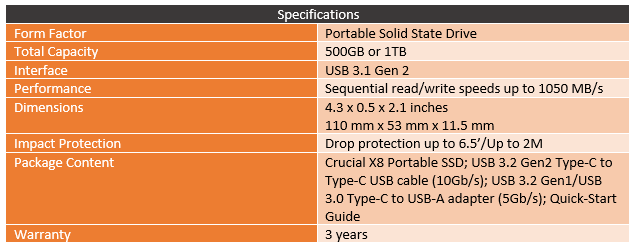The portable storage market is mostly split up into three categories. You have flash or thumb drives, portable external drives, then large capacity full-sized external drives. What you need to use the drive for will determine which type you might need. But over the years one thing is for sure, thumb drives have taken over the market. They are small, portable, and they have been quick. But have you ever shopped for extremely high capacity thumb drives? To get a 1TB thumb drive you end up giving up a lot of that portability and performance is mediocre at best and the pricing can get really crazy. Not to mention there are a lot of fakes, even Amazon has them right at the top of the listings when you search for 1TB thumb drives. 1TB portable hard drives have been around for a long time but they are big and bulky, even when you get one based on 2.5-inch drives and they are extremely slow. This is why the portable SSD market has been taking off, you can get impressive performance, portability, and a capacity big enough to use as a game drive or to transport your important files. Well Crucial has finally jumped into the market with their introduction of the X8 and I finally have one in. I’m excited to check out the performance and see if it is faster than the two other portable SSDs that I use with my laptop.
Product Name: Crucial X8 1TB Portable SSD
Review Sample Provided by: Crucial
Written by: Wes Compton
Amazon Affiliate Link: HERE
Packaging
The Crucial X8 comes packed up in a package that looks exactly like the last 2.5 inch Crucial SSD that I had come in. This has a dark blue background with a fade behind a picture of the drive in the center. The Crucial logo is up in the corner, highlighted by a light blue box. I think having the actual drive picture on the front is great and is very important. Crucial also makes the drive capacity very clear with it listed in the bottom right corner and also on the top edge as well. Below that they hit at the potential performance with an up to 1050 MB/s section and support for Windows, Mac, PS4, and Xbox One all listed. I did notice that our box has kind of a fuzziness to the entire print, I don’t know if maybe our sample’s box is a prelaunch box or if they had other issues. Around on the back there isn’t much going on. There is a link to support and they repeat the drive speeds across every language you can think of.


Now as far as inside of the box. Well, there is a plastic tray that has the USB cable wrapped up on the bottom. On top of that the X8 itself comes wrapped in plastic and inside of the tray. Beyond that, there is a small paper folded up as a welcome or startup guide which mostly is filled with the same information repeated in different languages.


Photos and Features
The Crucial X8 is all black and is shaped in a lot of ways like an old cell phone before everyone started going with bigger and bigger models. It’s a rectangle but a rectangle that every single edge has been rounded off. This is basically the exact opposite of the WD My Passport SSD that I took a look at two years ago, where that was boxy. The middle section on the Crucial X8 is aluminum and part of its unibody construction. It isn’t just a sheet metal outside layer, you can fee just how solid it feels as soon as you hold it. It has some weight to it. The two end caps which help give it that rounded off shape have a rubberized coating on them but not a thick rubber coating for drops like the SanDisk Extreme Portable SSD. Even without additional drop protection, just with the unibody construction, Crucial does have the X8 listed with drop protection up to 2 meters or 6.5 feet. The X8 is also really interesting in that it is very minimal on its branding and because both sides have the same rounded shape it is all exclusively on the glossy strip along the top on both sides. One has the Crucial by Micron logo and the other side has the actual model name along with the capacity and all of the normally required certifications are also laser cut on it as well. The overall size of the X8 is a little larger than the WD Passport SSD with the length measuring 110 mm for me. It is 53 mm tall and then 11.5 mm thick as well were the WD was 90 x 45 x 10. But even being larger, the X8 is pocketable, especially with the all rounded shape, just don’t forget your cord!


The two ends of the drive do a lot better job os showing the rounded shape, not only do the ends round off the corners, but you can see that the side profile of the unibody center has an oval shape as well. There is just one port directly in the center and they kept things extremely simple with it being a newer USB Type-C Gen 2 plug. With USB Type-C becoming popular with new phones for a few years now it is nice to see Crucial stick with it. They went with it for the performance of course, but even beyond that, It is a lot easier to use with its reversible design and it is more solid and less likely to be damaged.


That brings me to the only accessories included with the X8. You get an extremely short USB Type-C Gen 2 cord that has Type-C connections on both ends. Then with that, you get a Type-C to Type-A adapter. Western Digital did the exact same thing with both of their SSD portables. Though I will say that I would much prefer the adapter have the option to maybe clip to the cord. I use Type-C on my laptop unless I am charging at the time, but often I need the adapter when I share files or need to use the drive on anything but the newest PCs and I have lost the adapters before and finding a replacement that will still transfer at the Gen 2 speeds can sometimes be a pain.


Performance
For performance testing, I had a few different areas that I wanted to check out on the Crucial X8. I expanded our portable SSD testing slightly as well as went with the tests I have always included. But first I did take a look at the drive using CrystalDiskInfo. So Crucial, being part of Micron did at least hide the drive information with a new model name when it is scanned. Often when an external drive is scanned it just shows the model for the original drive. But the firmware listed clues us into the magic behind the X8. The P3CR013 firmware is the July 23rd release for the Crucial P1 M.2 drive. This isn’t a big shocker, I expected the X8 to be the P1. I had the chance to test the P1 back in December of 2018 and have been extremely happy using the drives as well. CDI also tells us that the drive is running via UASP or USB Attached SCSI Protocol.
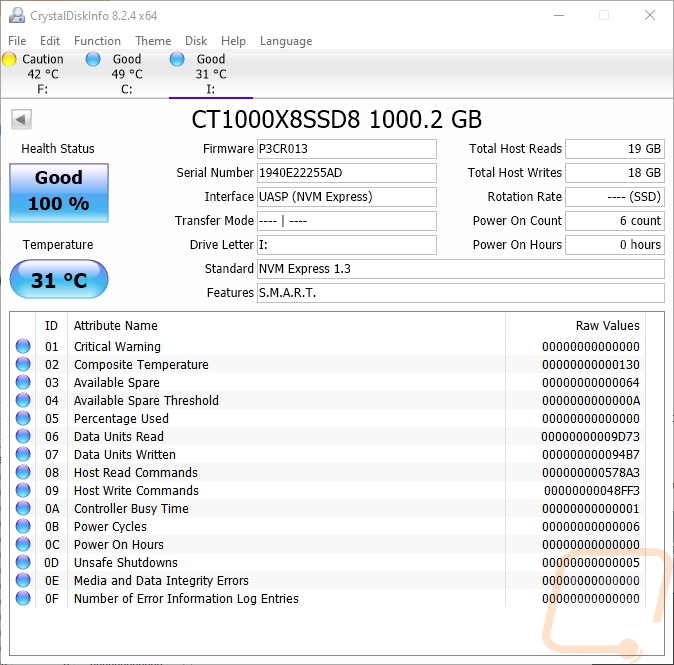
For my first benchmark, I used CrystalDiskMark to check out the sequential performance. I did run both the older version I have been using for a while now and the new CDM 7. The older version runs a higher 32 queue depth with one thread for the first results were CDM 7 does 8 queue with 1 thread and you cans ee the performance difference between the two. The second result with a queue depth of 1 and 1 thread is also not bad at 853.61 MB/s read and 847.88 write. Overall comparing the CDM 6 results with our older SanDisk and WD portable SSD results the X8 is significantly faster.
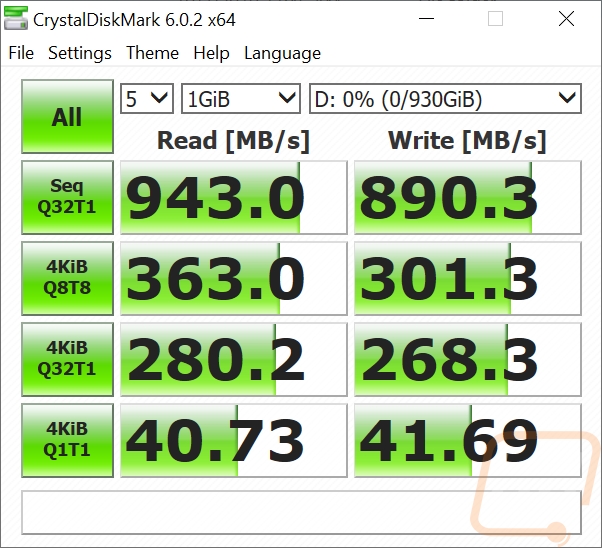
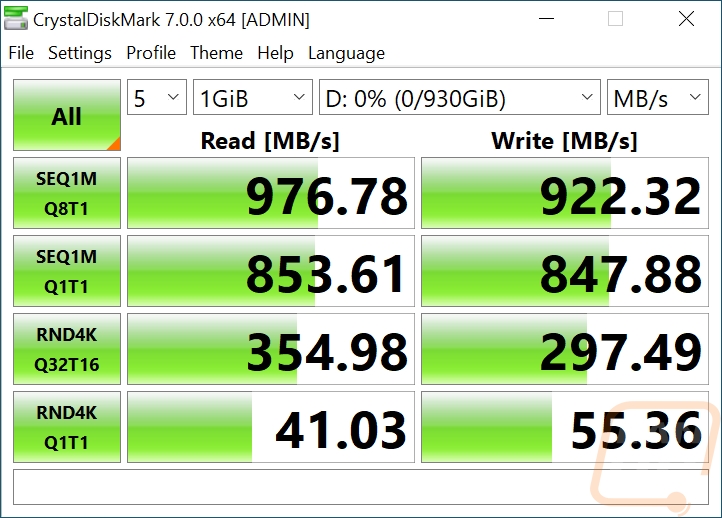
Anvil’s Storage Utilities shows sequential numbers up in the high 800’s for read speeds and 744 for write. But I was mostly interested in the QD16 IOPS which have read IOPS at 70489 and write IOPS at 51035. Comparing this with the SanDisk which was similar on read IOPS but was extremely low on write IOPS at 2444 shows just how fast the X8 is.
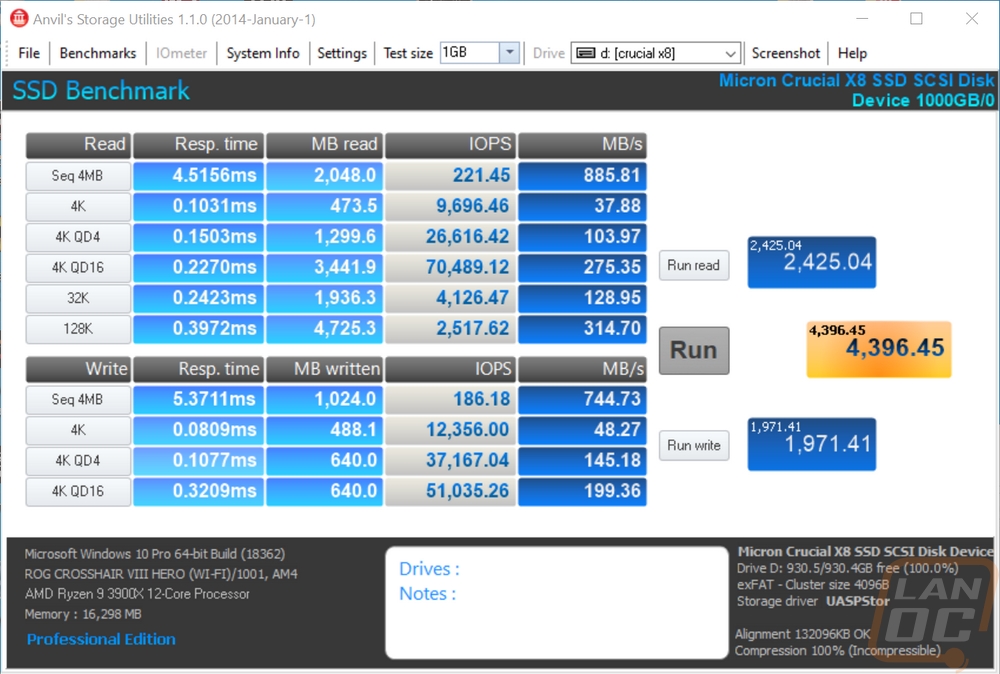
For ATTO which I don’t always use, I added it back to our test suite and have both the Bytes per second numbers and the IOPS as well. You can see on the transfer speeds that results cap out around 512 KB file size and do very well on anything larger than that with write speeds around 880 MB/s and read speeds at 930 MB/s. The IOPS, on the other hand, are highest on the low end peaking at 31000 write and 29600 for read.
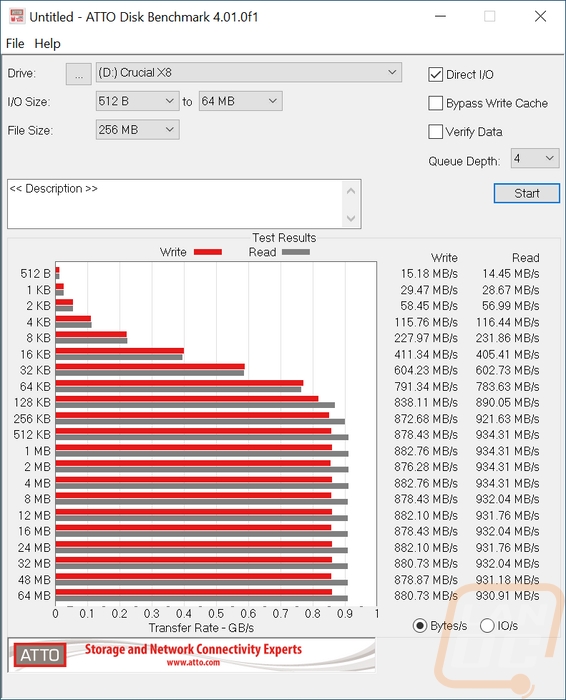
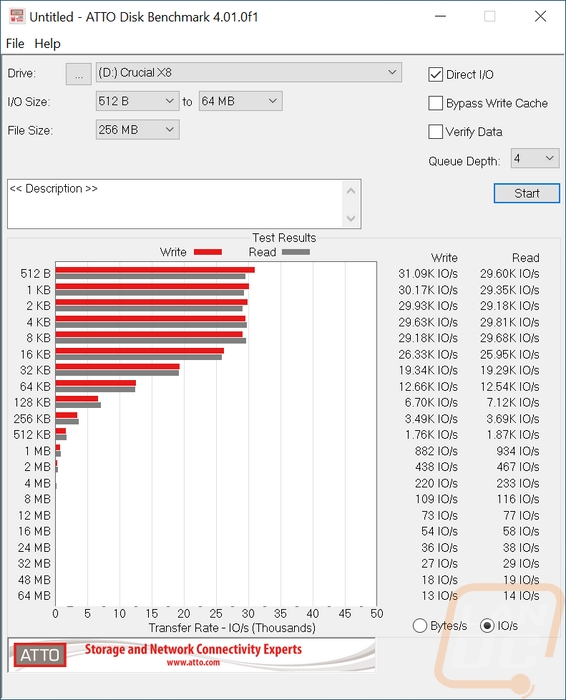
I think my favorite tests are the real-world tests. I do a total of 6 using three different file types. I transfer a folder filled with word documents, a folder filled with RAW and JOG images, and then a folder with a 9/10GB movie file. I test transferring to the X8 and also from the X8 back to our PC which btw is sporting a new Gen4 PCIe SSD. The word documents are by far the slowest with them going to the X8 at 411 KB/s and from the drive at 571 KB/s, this is about what you would experience with any folder filled with lots of small files. Photos are also small, but a lot larger than the word documents and it shows the transfer speeds. I saw 179 MB/s when writing to the X8 with a few big dips which might be when the image sizes got smaller (I transferred our review photo folders which have RAW, then edited jpgs, and then compressed and watermarked JPGs). Reading from the drive and copying to the PC things sped up to around 283 MB/s at times with a portion of the transfer lower. Then the last transfers were with the movie file where I saw a hard cap of 599 MB/s when writing to the X8 and a consistent 791 MB/s reading and moving back to the PC. The WD Passport SSD, on the other hand, wrote a similar movie at 362 MB/s and the SanDisk did 195 MB/s to the drive and 421 MB/s back to the PC. Both of those drives were fast, but the Crucial X8 is significantly quicker though I do think the small document transfers for the SanDisk were faster at 4 MB/s write and 6 MB/s read.
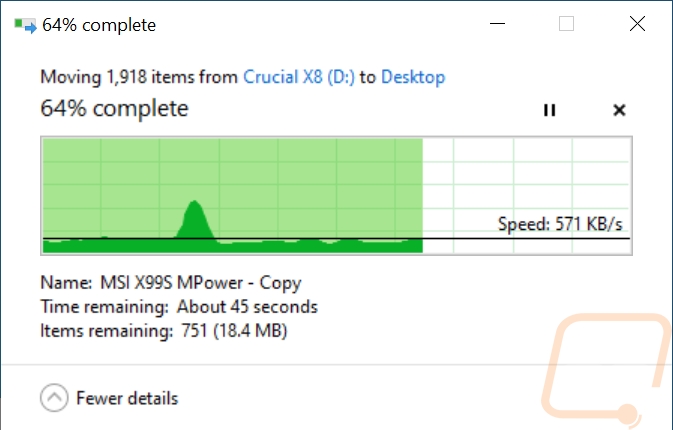
Documents transferred to PC
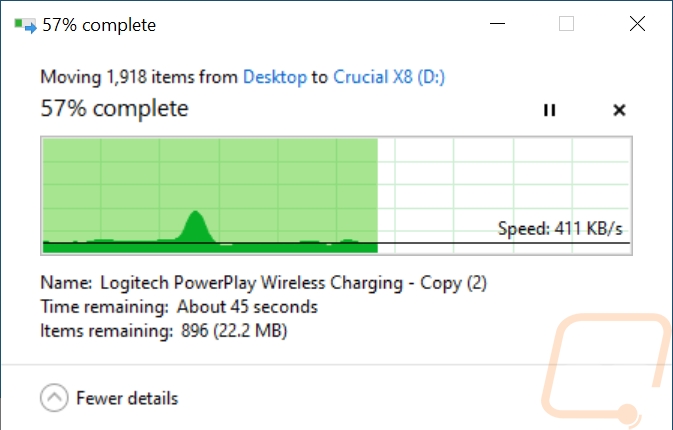
Documents transferred to X8
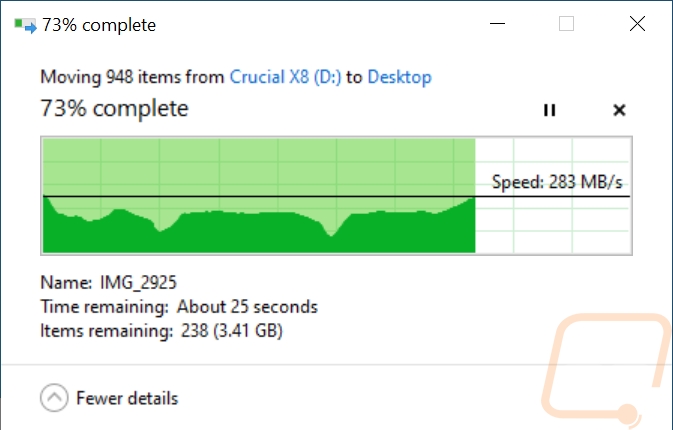
Photos transferred to PC
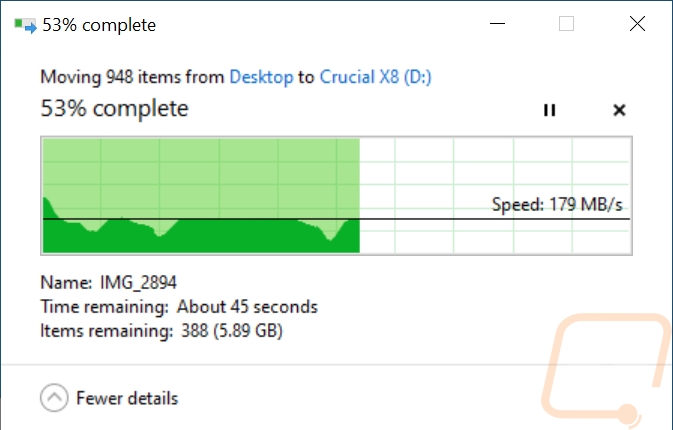
Photos transferred to X8
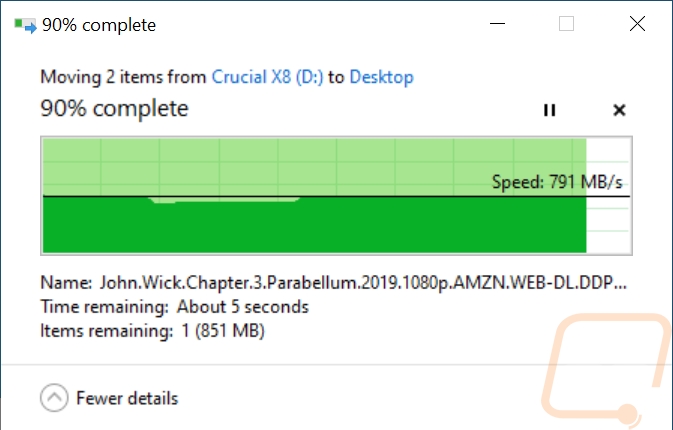
Movie transferred to PC
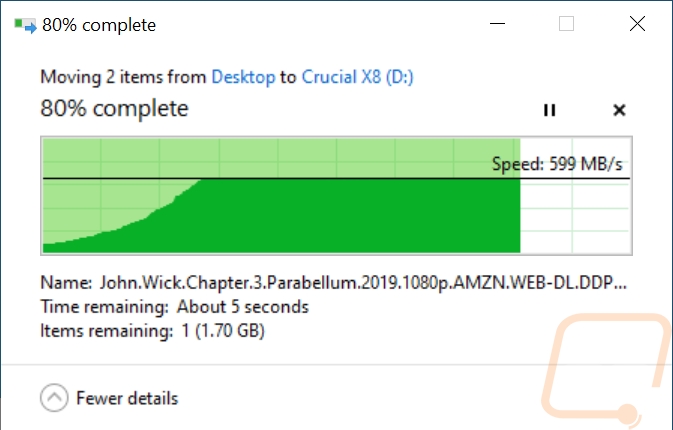
Movie transferred to X8
I saved the most demanding benchmarks for last. These were done using AIDA64’s built-in disk benchmark. I ran a full 100% read speed test that tests the entire size of the drive There was a small initial dip down to 790 MB/s but the drive was very consistent from there on at between 902 and 892 MB/s. Now the write test is the extra demanding one, it overwrites the entire drive in one action over time and you can see it took 149 minutes in total. For the first 32% of the drive it was solid in the 800 MB/s range. After that it did reach the end of the SLC cache on the drive and you can see a constant up and down motion where it would drop all the way down to 89.2 MB/s. This is a little concerning, but this situation would only come up if you are writing over 320 gigs to the drive all at once, as long as you keep your single transfers under that you will always get that high-end SSD performance. But it is important to keep in mind, the X8 does have at least one limitation.
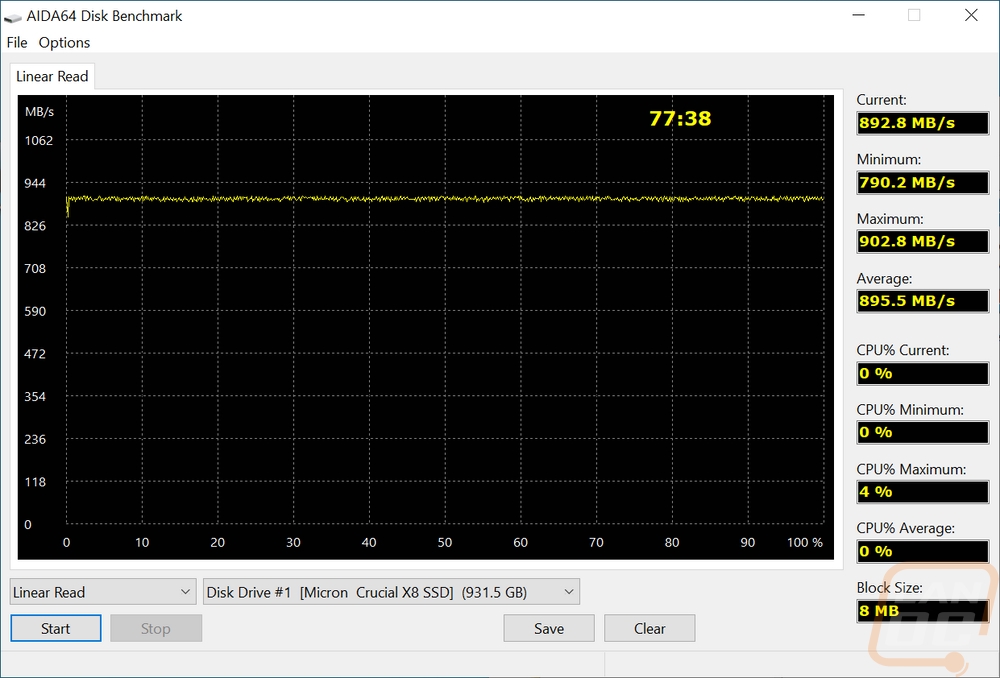
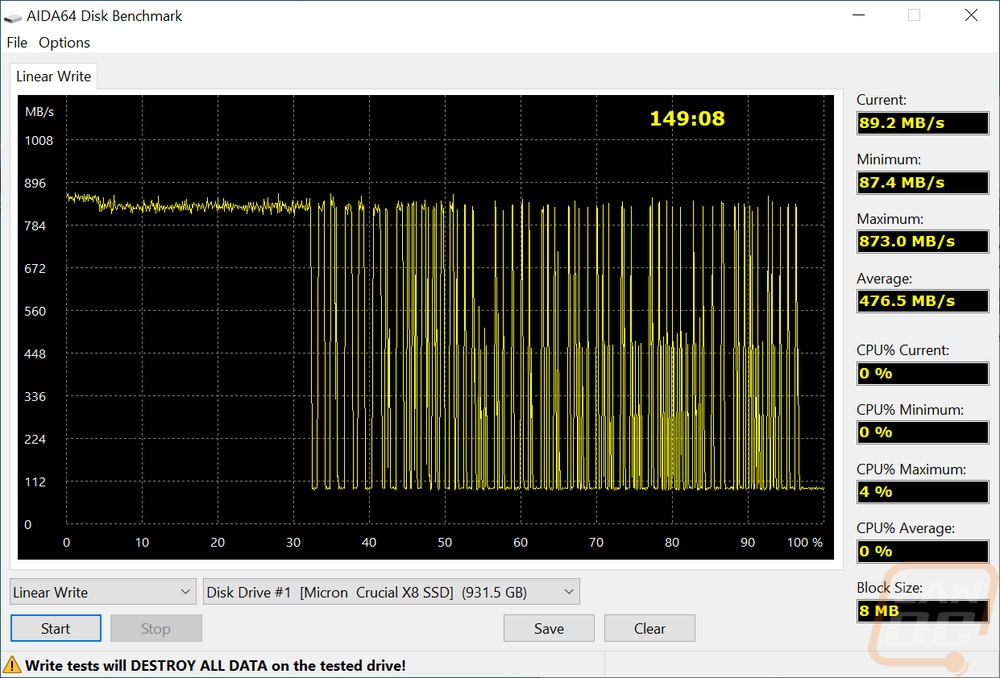
Overall and Final Verdict
Well, Crucial did a great job jumping into the portable SSD market with their X8. Using the Crucial P1 M.2 drive as a base they had solid performance on lock in all of our tests, especially the sequential transfers. Getting down into small files I have seen portable SSD’s that perform faster but overall this is the fastest portable drive I have tested. Being their first portable drive, it was also a new foray into the physical side of things with the casing keeping the X8 all together. They went with a unibody design that is very strong and does have good drop ratings, even without any extra rubber bumpers like the Extreme drives from SanDisk. It did end up being larger than the WD Passport SSD that I use often, but not by a lot and the curvy shape makes the X8 very pocketable. It slides right in your pocket or into a pocket in your laptop bag like I use mine.
The drive does run into issues when you do a full drive nonstop write at around 32% of the way in. This is where the SLC cache runs into issues. But I don’t see many situations where people will be transferring one file that large. My only other suggestion for improvement is with the cord and it is an issue all of the portable SSD’s seem to have. I love that they went with Type-C for both ends, but I would like to see the Type-C to Type-A adapter be attachable to the cord so it isn’t easy to lose. I’ve lost them on past drives and even as I write this I’m not 100% sure where the adapter is after doing my drive testing.
As with all forms of storage, pricing is still very important and the X8 comes in two capacities 500GB and 1TB. The 1TB drive is $164.95 right now and the 500 GB model is $129.95. There are portable SSD’s available for cheaper, but most are SATA based drives. The NVMe drives like the SanDisk Extreme and the WD Passport SSD, and the Samsung X5 are all closer to the pricing of the X8. The WD drives have dropped significantly and are cheaper than the X8, but the X8 is also a faster drive. The Samsung is much more expensive and the SanDisk, even with the older slower model is priced right with the X8 at 169.99 for the 1TB model. This makes the Crucial X8 actually a good buy in the portable SSD market all things considering. The P1 which it is based on was a high-performance high-value drive as well so I guess it shouldn’t be a big surprise, but overall I think Crucial has a good drive with the X8. It is also faster and in a lot of cases cheaper than the 1TB flash drive options as well making it a good choice when you need high speeds along with high capacity.


Live Pricing: HERE


